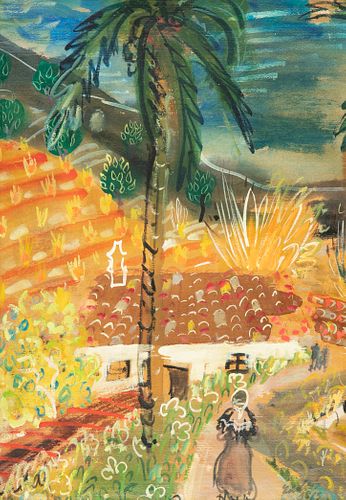CARLES NADAL FARRERAS (Paris, 1917 - Sitges, Barcelona, 1998). "Landscape with figure", 1963. Oil on canvas. Signed and dated in the lower right corne
Lot 124
About Seller
Setdart Auction House
Carrer Aragó 346
Barcelona
Spain
Setdart Subastas was born in 2004 and is currently the first online art auction in Spain with solidity, prestige and reliability guaranteed by our more than 60,000 users. Setdart has a young, dynamic and enterprising team ready to successfully manage the purchase and sale of art works through custom...Read more
Estimate:
$8,000 - $10,000
Absentee vs Live bid
Two ways to bid:
- Leave a max absentee bid and the platform will bid on your behalf up to your maximum bid during the live auction.
- Bid live during the auction and your bids will be submitted real-time to the auctioneer.
Bid Increments
| Price | Bid Increment |
|---|---|
| $0 | $10 |
| $200 | $25 |
| $500 | $50 |
| $1,000 | $100 |
| $3,000 | $200 |
| $5,000 | $500 |
| $10,000 | $1,000 |
| $20,000 | $2,000 |
| $50,000 | $5,000 |
About Auction
By Setdart Auction House
Jun 17, 2021
Set Reminder
2021-06-17 06:15:00
2021-06-17 06:15:00
America/New_York
Bidsquare
Bidsquare : 19th & 20th Century Contemporary Art - Select Lots
https://www.bidsquare.com/auctions/setdart-auction-house/19th-20th-century-contemporary-art---select-lots-7081
Setdart Auction House sofia@setdart.com
Setdart Auction House sofia@setdart.com
- Lot Description
CARLES NADAL FARRERAS (Paris, 1917 - Sitges, Barcelona, 1998). "Landscape with figure", 1963. Oil on canvas. Signed and dated in the lower right corner. Measurements: 30 x 40 cm; 57 x 66 cm (frame). Nadal's works offer a version of the world from a naïve perspective, in which the joy of living is optimized. They are pictorial spaces conceived and dedicated to leisure, where the characters develop freely, immersed in open landscapes, in contact with nature. The chromatic range supports these concepts, using a palette of bright shades, where yellow becomes the undisputed protagonist. Nadal's paintings have always been linked to the artistic production of the Fauvists, especially to Dufy, whose work exerted a great influence. The son of Santiago Nadal, a decorative painter based in Paris, Carles Nadal has lived in Barcelona since childhood, where the family moved due to his father's illness. At the age of thirteen he began to work as an apprentice in a decorative painting workshop, and in 1936 he received a scholarship from the City Council of Barcelona to study at the School of Fine Arts of Sant Jordi. At the outbreak of the Civil War he was enrolled in the Republican army, with which he fought on the fronts of Aragon and Tremp. At the beginning of 1939 he crosses the French border and is interned in the refugee camp of Saint Cyprien, where he remains for several months. He manages to escape and cross the border again, but is arrested and imprisoned in Figueras. Under parole he returns to Barcelona, where he continues his artistic career while simultaneously working as a decorator and studying Fine Arts. In 1941 he makes his debut in a collective exhibition at the Dalmau Gallery, obtaining good reviews. He finishes his studies with good grades, obtaining the recognition of teachers and professors, some of whom will become friends and collaborators of the young Nadal. In fact, it was one of them, Luis Muntané, who facilitated his first individual exhibition in 1944, at La Pinacoteca in Barcelona. Two years later he moved to Paris, again with a grant from the Barcelona City Council. There he works and exhibits with the group Présence de l'Homme, as well as participating in the Salons d'Automne. Later, thanks to a scholarship from the French State, he attends the Paris School of Fine Arts. In 1948 he married Flore Joris, establishing his residence in Brussels, where he remained until the mid-seventies. In Belgium he discovered, as he himself repeatedly stated, light and color. During these years he will continue to show his work in Spain and Belgium as well as in France, Germany, Holland, Switzerland, the United Kingdom and the United States. Nadal's painting is post-impressionist, intensely colorful, and is based on the search for chromatic force as the most direct means of communication. His awards include the Grand Prix of Spa, Belgium, and his appointment as a member of the Royal Academy of London. His works are in the Museum of Modern Art in Barcelona, the Spa Museum in Belgium and the Royal Museum in Brussels.
- Shipping Info
-
In-house shipping available. Please inquire at admin@setdart.com.
-
- Buyer's Premium



 EUR
EUR CAD
CAD AUD
AUD GBP
GBP MXN
MXN HKD
HKD CNY
CNY MYR
MYR SEK
SEK SGD
SGD CHF
CHF THB
THB
















